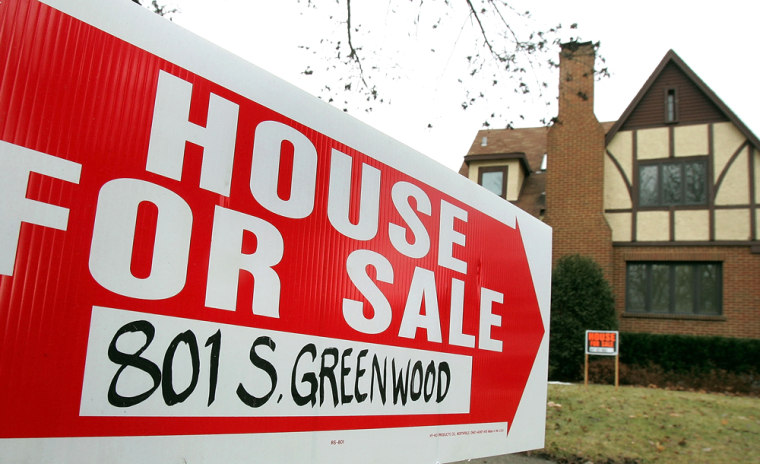Sales of existing homes fell for a third straight month in December to their lowest rate in nearly two years, a trade group reported Wednesday in a report that pointed to further slowing in housing.
Sales fell 5.7 percent last month to a seasonally adjusted annual rate of 6.6 million units, which was a sharper slowdown than expected. But for the year, 7.07 million homes were sold, making 2005 the fifth straight year of record home sales, the National Association of Realtors said.
December’s sales rate compared with an upwardly revised 7.0 million unit pace in November. The existing home figure includes both single-family homes and condos.
Analysts had expected overall sales to decline to an annual rate of 6.9 million units from an originally reported rate of 6.97 million.
"All good things must come to an end, and I guess that pertains to the housing market," said Joel Naroff of Naroff Economic Advisors.
The decline in sales last month was driven by a 6.8 percent drop in single-family home sales. Condo sales rose 1.6 percent in December.
"The biggest problem is in the single-family market, where sales are beginning to tank," Naroff said in a note. Strong condo sales are keeping prices stable, "but supply is becoming an issue for both markets, and that could lead to some real pressure on prices."
Inventories declined in December by 4.4 percent to 2.8 million existing homes. That equates to 5.1 months’ supply at the current sales pace.
He predicted prices could fall this year, especially if mortgage rates rise. Recently they have been drifting lower, although they are significantly higher than their lows of mid-2005.
December’s sales drop signaled further cooling in the housing market after five years of gains that shattered construction and sales records and sent prices up more than 50 percent nationwide.
David Lereah, the Realtors’ chief economist, said housing was cooling due to a rise in mortgage rates over 2005 and high prices in hot markets.
But he also noted that some of the slowing was happening in markets that never experienced a housing boom, such as Detroit, Columbus, Ohio, and other markets in the Midwest. He said job losses and slowing local economies were hurting housing there.
Nationwide, prices in 2005 rose about 12.7 percent, but as the market cools and mortgage rates rise, price appreciation should slow to about 6 percent in 2006, Lereah said.
Price gains already have begun to ease, the Realtors group said, noting price appreciation hit 16.6 percent in October and then slowed to 13 percent in November and 10.5 percent in December.
The national median sales price in December was $211,000, compared with $191,00 a year earlier, the group said.
Sales of existing homes set a record for a fifth straight year in 2005 even though the year ended on a weaker note with three straight monthly declines, sending a strong signal that the nation’s housing boom is beginning to cool.
The National Association of Realtors reported that sales of previously owned homes and condominiums dropped by 5.7 percent in December compared to the sales pace in November. It marked the third consecutive monthly decline, something that has not occurred in more than three years.
Celia Chen, director of housing economics at Moody's Economy.com, said sales are softening and sellers are having a harder time getting their asking price. She predicted a "significant slowdown" by midyear.
"Sales have been running ahead of the long-term demand indicators for the last few years thanks to the unusually low mortgage interest rates," she said in a brief report. "Moreover, the growing presence of investors and holders of non-traditional mortgages in the market add to the downside risks for housing."
Even with the sales weakness in the last three months of the year, total sales in 2005 climbed to an all-time high of 7.072 million units, up 4.2 percent from the 6.784 million homes and condominiums sold in 2004.
The median price of a home sold in December was $211,000. For all of 2005, home prices were up 12.7 percent, the biggest increase since a 14.4 percent rise in 1979.
David Lereah, chief economist for the Realtors, said he expected price increases to slow this year as sales drop by around 5 percent. He said this would represent a cooling housing market but not a collapse as some analysts had feared.
“This is part of the market adjustment we have been discussing with a soft landing in sight for the housing sector,” Lereah said.
By region of the country, sales were down 11.4 percent in the West, 7.2 percent in the South and 2.6 percent in the Midwest. The level of sales was unchanged in the Northeast.
Lereah said he expected sales of existing homes to decline by 5 percent in 2006 and expected a similar drop for sales of new homes. He said that the 12.7 percent increase in prices last year would probably slow to a gain of around 5 percent or 6 percent in 2006.
